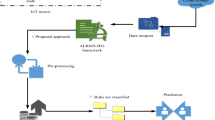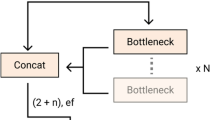Abstract
Accidents often occur in the earth—typhoons, floods, earthquakes, traffic accidents and so on. Whether these accidents can be timely and effectively responded to has been an important indicator to judge whether a region is advanced or not. IoT provide a possibility to solve such emergent problems by intelligent monitoring, diagnosis and repair. For example, coastal cities are often attacked by typhoons, if typhoon meteorological identification and early warning can be effectively carried out, many unnecessary property and personnel losses can be reduced. Accurate typhoon prediction has very important practical significance. However, current typhoon monitoring and prediction are mainly based on simulation with meteorological data; the accuracy still needs to be improved. Nowadays, the technology of Internet of Things (IoT) and remote sensing technology become more and more closely linked; many IoT systems in smart cities’ can obtain high-resolution remote sensing image data. Therefore, it is possible to use urban IoT system to realize the early warning of typhoon. In this paper, we propose a deep learning method for typhoon cloud recognition and typhoon center location, and design a general algorithm framework, including data preprocessing, model training and parameter selection, test and result analysis. Besides, we implement a typhoon early warning demo system. The experimental results show that our algorithm is better than the traditional methods in recognition accuracy.
















Similar content being viewed by others
References
Tsutsui K, Rokugawa S, Nakagawa H et al (2007) Detection and volume estimation of large-scale landslides based on elevation-change analysis using DEMs extracted from high-resolution satellite stereo imagery. IEEE Trans Geosci Remote Sens 45(6):1681–1696
Pagano A, Giordano R, Portoghese I et al (2014) A Bayesian vulnerability assessment tool for drinking water mains under extreme events. Nat Hazards 74(3):2193–2227
Lo SW, Wu JH, Lin FP et al (2015) Visual sensing for urban flood monitoring. Sensors 15(8):20006–20029
Furquim G, Filho GPR, Jalali R et al (2018) How to improve fault tolerance in disaster predictions: a case study about flash floods using IoT, ML and real data. Sensors 18(3):907
Wei CC (2012) Wavelet kernel support vector machines forecasting techniques: case study on water-level predictions during typhoons. Expert Syst Appl 39(5):5189–5199
Hong JI, Heer J, Waterson S et al (2001) WebQuilt: a proxy-based approach to remote web usability testing. ACM Trans Inf Syst 19(3):263–285
Sardar Z (2015) Postnormal times revisited. Futures 67:26–39
Tsai SC, Kiang JF (2011) Floating dropsondes with DGPS receiver for real-time typhoon monitoring. IEEE Trans Geosci Remote Sens 49(11):4363–4373
Wang X, Ren Y, Li X (2016) The warm-core structure of Super Typhoon Rammasun derived by FY-3C microwave temperature sounder measurements. Atmos Sci Lett 17(8):432–436
Tsujino S, Tsuboki K, Kuo HC (2017) Structure and maintenance mechanism of long-lived concentric eyewalls associated with simulated typhoon bolaven (2012). J Atmos Sci 74(11):3609–3634
Monteleoni C, Schmidt GA, Mcquade S (2013) Climate informatics: accelerating discovering in climate science with machine learning. Comput Sci Eng 15(5):32–40
Moon W, Wettlaufer JS (2017) A unified nonlinear stochastic time series analysis for climate science. Sci Rep 7:44228
Huang JZ, Li DS, Li HN et al (2018) Damage identification of a large cable-stayed bridge with novel cointegrated Kalman filter method under changing environments. Struct Control Health Monit 4:e2152
Zhang Q, Yang W, Zhang S et al (2018) Characteristics of BeiDou navigation satellite system multipath and its mitigation method based on Kalman filter and Rauch-Tung-Striebel smoother. Sensors 18(1):198
Keshtegar B, Heddam S (2017) Modeling daily dissolved oxygen concentration using modified response surface method and artificial neural network: a comparative study. Neural Comput Appl 30:2995–3006
Torres-Barrán A, Alaíz CM, Dorronsoro JR (2017) Ν-SVM solutions of constrained Lasso and Elastic net. Neurocomputing 275:1921–1931
Pradhan R, Aygun R, Maskey M et al (2017) Tropical cyclone intensity estimation using a deep convolutional neural network. IEEE Trans Image Process PP(99):1
Ali MM, Jagadeesh PSV, Lin II et al (2012) A neural network approach to estimate tropical cyclone heat potential in the Indian Ocean. IEEE Geosci Remote Sens Lett 9(6):1114–1117
Loridan T, Crompton RP, Dubossarsky E (2017) A machine learning approach to modeling tropical cyclone wind field uncertainty. Mon Weather Rev 145(8):3203–3221
Marmanis D, Datcu M, Esch T et al (2016) Deep learning earth observation classification using ImageNet pretrained networks. IEEE Geosci Remote Sens Lett 13(1):105–109
Ren S, He K, Girshick R et al (2017) Faster R-CNN: towards real-time object detection with region proposal networks. IEEE Trans Pattern Anal Mach Intell 39(6):1137–1149
Peng P, Tian Y, Xiang T et al (2017) Joint semantic and latent attribute modelling for cross-class transfer learning. IEEE Trans Pattern Anal Mach Intell 40(7):1625–1638
Acknowledgements
The work is supported in part by the National Natural Science Foundation of China (No. 61572157), Grant Nos. 2016A030313660 and 2017A030313365 from Guangdong Province Natural Science Foundation, Shenzhen Municipal Science and Technology Innovation Project, JCYJ20160608161351559, KQJSCX70726103044992, KQJSCX20170327161655607 and JCYJ20170811155158682.
Author information
Authors and Affiliations
Corresponding author
Additional information
Publisher's Note
Springer Nature remains neutral with regard to jurisdictional claims in published maps and institutional affiliations.
Rights and permissions
About this article
Cite this article
Wang, E.K., Wang, F., Kumari, S. et al. Intelligent monitor for typhoon in IoT system of smart city. J Supercomput 77, 3024–3043 (2021). https://doi.org/10.1007/s11227-020-03381-0
Published:
Issue Date:
DOI: https://doi.org/10.1007/s11227-020-03381-0




